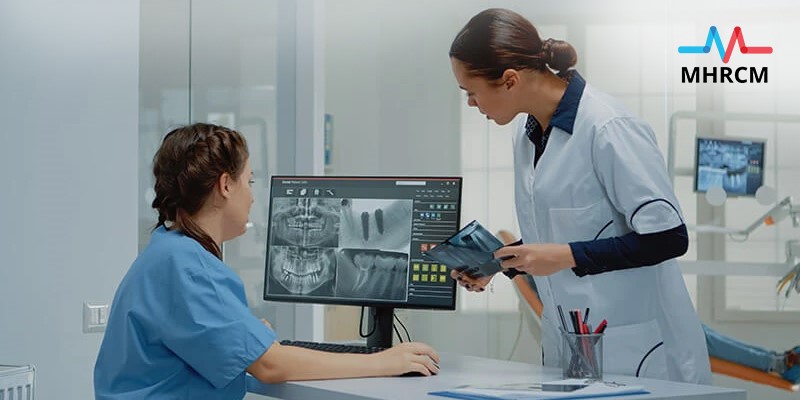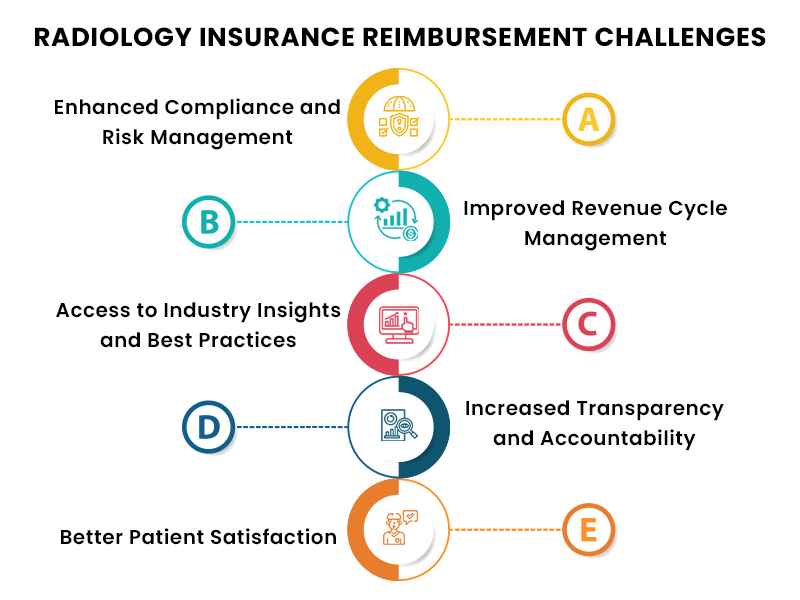By Leo John
Tips to Improve Radiology Medical Billing in Healthcare Industry
What is Radiology Billing? Industry

How Does Radiology Billing and Coding Work?
Radiology Billing and Coding Involves Several Steps
The first step is to collect patient demographic information, such as name, address, contact number, and insurance information. This information is entered into the hospital’s Billing System.
Scheduling the Radiology Service, where the type of imaging test and the CPT Code is identified is the second step. The CPT Code is a Numerical Code used to identify the specific service provided.
The third step is to confirm insurance coverage for the Radiology Service. This process is called Pre–Authorization, and it involves contacting the insurance company to ensure that the service is covered.
This step involves Coding the Radiology Service, where the CPT Codes are assigned to the service provided. This helps to ensure that the correct Billing Codes are used for each service, as this can affect reimbursement rates.
Submitting the Claim is the fifth step in Radiology Billing. The Claim is Submitted to the insurance company or government program. The Claim includes the patient’s demographic information, the service provided, and the CPT Codes assigned to the service.
This step involves recording the Payments and Denials received from the insurance company or government program. This helps to ensure that all Payments and Denials are accurately recorded.
The final step involves Collecting Outstanding Balances from patients. This can involve sending bills and following up with patients to ensure that Outstanding Balances are paid in a timely manner.
Radiology CPT Codes
Radiology CPT Codes are an essential aspect of Radiology Medical Billing. These Codes describe the Radiology Procedures and Services provided to patients. The use of correct CPT Codes is critical for accurate Billing, ensuring timely Reimbursement, and avoiding Denials.
Radiology CPT Codes are categorized into two main groups: Imaging and Non-imaging Codes. Imaging Codes describe the use of Imaging Technology to diagnose and treat medical conditions, while Non-imaging Codes describe other services related to Radiology, such as Radiology Consultation and Interpretation Services.
Imaging Codes are further categorized based on the type of Imaging Technology used. For instance, X-ray Codes describe the use of X-ray Imaging Technology, while CT Scan Codes describe the use of CT Scan Imaging Technology. MRI and Ultrasound Codes are other examples of Imaging Codes used in Radiology Billing.
Radiology CPT Codes are updated annually by the American Medical Association (AMA). These updates include New Codes, Deleted Codes, and Revised Codes. Staying up-to-date with the latest CPT Codes is essential to ensure Accurate Billing and Avoid Denials.
Correctly identifying the CPT Codes can be challenging, as some procedures may fall under multiple Code Categories. In such cases, Radiology Billing Professionals should consult with the Radiologist or Physician to determine the correct Code to use.
Radiology CPT Codes also play a role in determining the reimbursement rates for Radiology Services. The reimbursement rates are determined based on the geographic location of the Healthcare organization and the type of insurance coverage provided to the patient.
Tips to Improve Radiology Medical Billing in Healthcare Industry
Accurate Coding is crucial for Radiology Billing. The correct CPT Codes should be assigned to the Radiology Service to ensure maximum reimbursement. The use of outdated or incorrect Codes can result in Denials and Delayed Payments. Improve the Coding Accuracy with a strong knowledge of the latest Coding changes, and ensure that Coders are well-trained and competent.
Documentation is critical for Radiology Medical Billing. Complete and Accurate Documentation of the Radiology Service is necessary to support the CPT Codes assigned. Improved Documentation can reduce Denials and increase Reimbursements. Radiologists and Technicians should be trained to document the Radiology Service accurately, including the type of Imaging Test, the body part imaged, and the medical necessity of the service.
Pre-authorization Processes can help confirm insurance coverage for the Radiology Service before the service is provided. This can reduce Denials and increase Reimbursements. Pre-authorization is a time-consuming process, but it can be streamlined by using Electronic Pre-authorization Tools and automating the process.
Radiology Billing is subject to Regulations and Guidelines. Staying up–to–date with these Regulations and Guidelines can ensure compliance and low risk of audits and penalties. Regular staff training and continuing education can help ensure that the Radiology Billing Team is aware of the latest Regulations and Guidelines.
Technology can improve Radiology Billing Processes. Electronic Medical Record Systems and Billing Software can help streamline the Billing Process and reduce errors. Automated Coding Tools can help ensure Coding Accuracy, and Claims Scrubbing Software can help identify potential issues before Claims are submitted.
Denials can be costly for Radiology Billing. Monitoring and tracking Denials can help identify trends and areas for improvement. By identifying the root causes of Denials, Healthcare organizations can develop strategies to reduce them. It is essential to track and analyze Denial Data regularly to identify patterns and make necessary improvements to the Billing Process.
Denied Claims should be Reviewed and Appealed promptly. Reviewing Denied Claims can help identify errors or discrepancies in the Billing Process. Appealing Denied Claims can help recover lost revenue and improve cash flow. A thorough understanding of Insurance Policies and Billing Regulations can help improve the success rate of appeals.
Training and Education are essential for Radiology Billing Staff. Regular Staff Training can ensure that staff members are up to date with the latest Coding and Billing Regulations. Staff members should be trained to identify Coding Errors, handle Claim Denials, and improve Documentation. Ongoing education can also help staff members stay informed about changes in the Healthcare industry and the latest technological advances.
Radiology Insurance Reimbursement Challenges

A challenging aspect of Radiology Care is Increasing Insurance Reimbursement. Insurance companies often have complex Reimbursement Policies, and Radiology Services are subject to high levels of scrutiny. Additionally, Insurance companies may deny claims based on the medical necessity of the Radiology Service. Addressing these challenges requires a comprehensive understanding of the Insurance Reimbursement Process and the ability to navigate complex policies.
One way to address these challenges is to work with a reputable Radiology Billing Service Provider. These providers specialize in Radiology Billing and are familiar with the latest Reimbursement Policies and Regulations. They can help Healthcare organizations improve Billing Accuracy, reduce Denials, and increase Reimbursement Rates
Outsourcing Radiology Medical Billing Services brings numerous advantages, from optimizing revenue and improving compliance to freeing up resources for core functions and enhancing patient satisfaction. It’s a strategic move that propels your practice toward long-term success in the Healthcare industry.
Here are five compelling reasons to Outsource Radiology Medical Billing Process.
Medical Billing Companies stay up-to-date with the ever-changing Healthcare Regulations, ensuring your practice remains compliant. They mitigate the risk of Coding Errors, Improper Documentation, and Billing Fraud, safeguarding your reputation and minimizing legal and financial liabilities.
Outsourcing Medical Billing streamlines the entire Revenue Cycle, from Patient Registration to Claim Submission, Denial Management, and Payment Posting. With dedicated experts overseeing the process, you can optimize revenue collection, reduce revenue leakage, and improve overall financial performance.
Billing companies possess a wealth of industry knowledge and insights gained from working with various Healthcare providers. By partnering with them, you can leverage their expertise, be updated with industry trends, and implement best practices to drive operational excellence and financial success.
Outsourcing Medical Billing introduces a layer of Transparency and Accountability into your Revenue Cycle Management. Detailed reports, regular performance reviews, and open communication channels provide you with clear visibility into your practice’s financial health, empowering you to make informed decisions and drive continuous improvement.
Efficient and accurate Medical Billing Processes contribute to a positive patient experience. Outsourcing enables timely and accurate Billing, streamlined Insurance Claims, and clear Communication with patients regarding their financial responsibilities. By enhancing patient satisfaction, you cultivate loyalty, generate positive reviews, and attract more patients to your practice. When Outsourcing Radiology Billing, it is important to choose a reputable service provider with experience in Radiology Billing. The service provider should have a good understanding of the updated news on Coding and Billing Regulations and have a track record of success in improving reimbursement rates and reducing denials. Contact MHRCM if you want to start immediately.
Conclusion:
FAQs:
What is Radiology Billing
Why is Accurate Coding Important for Radiology Billing?
How can Pre-authorization Processes Help improve Radiology Billing?
What are some challenges of increasing Insurance Reimbursement for Radiology Services?
How can Outsourcing Radiology Billing help Healthcare Organizations?
Related Resource :
About the Author





